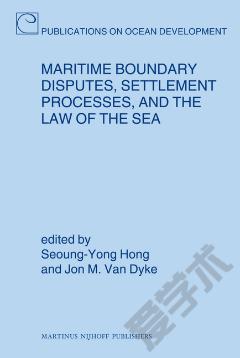Predictability and Flexibility in the Law of Maritime Delimitation
Chapter I: Preliminary Considerations Section I Nature of the Problem Section II Concept of Maritime Delimitation Part One: The Evolution of Law of Maritime Delimitation: Opposition of Two Basic Approaches Chapter II: Law of Maritime Delimitation Prior to the 1958 Geneva Conventions: Emergence of Two Approaches Section I Five Principal Systems of Maritime Delimitation Section II Discussion at the Hague Conference for the Codification of International Law in 1930 Section III Summary Chapter III: The 1958 Geneva Conventions and the 1982 UN Convention on the Law of the Sea Section I The 1958 Geneva Conventions Section II The 1982 UN Convention on the Law of the Sea Chapter IV: Opposition of Two Approaches in the Case Law I: Continental Shelf Delimitation Section I The North Sea Continental Shelf Cases (1969, Federal Republic of Germany/Denmark, the Netherlands) Section II The Anglo-French Continental Shelf Case (France/United Kingdom, 1977) Section III The Tunisia/Libya Case (1982) Section IV The Libya/Malta Case (1985) Chapter V: Opposition of Two Approaches in the Case Law II: Single/Coincident Maritime Boundaries Section I The Gulf of Maine Case (United States/Canada, 1984) Section II The Guinea/Guinea-Bissau Case (1985) Section III The St Pierre and Miquelon Case (France/Canada, 1992) Section IV The Greenland/Jan Mayen Case (Denmark/Norway, 1993) Section V The Eritrea/Yemen Case: the Second Stage (1999) Section VI The Qatar/Bahrain Case (Merits, 2001) Section VII The Cameroon/Nigeria Case (Merits 2002) Section VIII Two Approaches to Equitable Principles in the Case Law Part Two: Comparative Analysis between the Case Law and State Practice Chapter VI: Predictability in the Law of Maritime Delimitation: The Applicability of the Equidistance Method at the First Stage of Delimitation Section I Method of Analysis Section II Analysis of State Practice Section III Analysis of the Case Law Section IV Discussion Chapter VII: Flexibility in the Law of Maritime Delimitation I: Geographical Factors Section I The Concept of Flexibility Section II Configuration of the Coast Section III Proportionality Section IV Presence of Islands Section V Baselines Section VI Geological and Geomorphological Factors Section VII The Presence of Third States Section VIII Position of Land Boundary Section IX Presence of Ice Chapter VIII: Flexibility in the Law of Maritime Delimitation II: Non-Geographical Factors Section I Economic Factors Section II Conduct of the Parties Section III Historic Rights Section IV Security Interests Section V Navigation Section VI Environmental Factors Section VII Traditional Livelihood Section VIII Summary Part Three: Balance between Predictability and Flexibility in the Law of Maritime Delimitation Chapter IX: Legal Framework Reconciling Predictability and Flexibility in the Law of Maritime Delimitation Section I Tension between Predictability and Flexibility in the Law of Maritime Delimitation Section II Identification of Relevant Circumstances Section III Balancing Relevant Circumstances Section IV The Quest for Reconciliation between Predictability and Flexibility in the Law of Maritime Delimitation Chapter X: General Conclusion
{{comment.content}}








 京公网安备 11010802027623号
京公网安备 11010802027623号